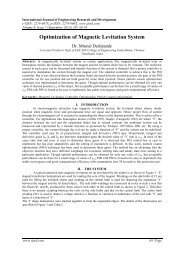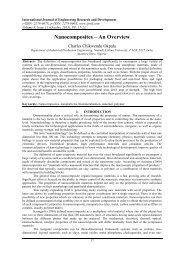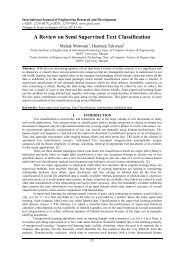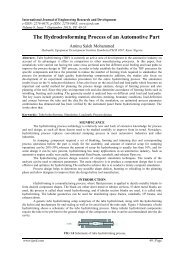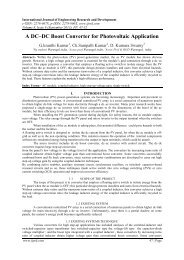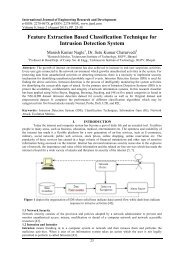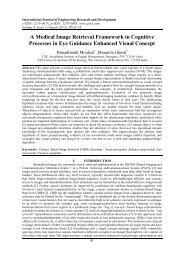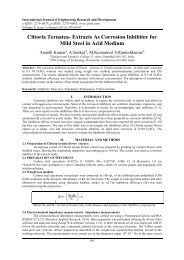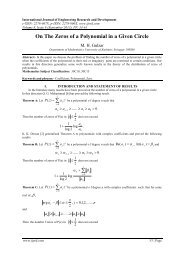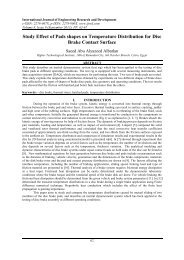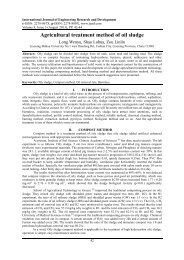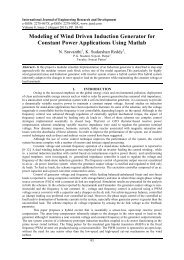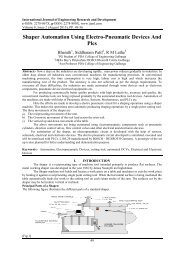D08101925.pdf
Create successful ePaper yourself
Turn your PDF publications into a flip-book with our unique Google optimized e-Paper software.
International Journal of Engineering Research and Development<br />
e-ISSN: 2278-067X, p-ISSN: 2278-800X, www.ijerd.com<br />
Volume 8, Issue 10 (October 2013), PP. 19-25<br />
Multicast Routing and Bandwidth Analysis Using<br />
Relay Node for Quality Video Transmission<br />
R.Shanthi 1 , T.K.Revathi 2 , Dr.J.Vellingiri 3 ,<br />
1 M.E-Student, Department of CSE, Kongunadu College of Engineering and Technology, Tamil Nadu, India.<br />
2 Asst. Professor, Department of CSE, Kongunadu College of Engineering and Technology,<br />
Tamil Nadu, India.<br />
3 Associate Professor, Department of CSE , Kongunadu College of Engineering and Technology,Tamil Nadu,<br />
India.<br />
Abstract:- This paper propose a novel scalable video broadcast/multicast solution that efficiently integrates<br />
scalable video coding, broadcast and ad-hoc forwarding to achieve the optimal trade-off between the systemwide<br />
and worst-case video quality perceived by all viewers in the cell. In our solution, video is encoded into one<br />
base layer and multiple enhancement layers using Scalable Video Coding (SVC). The large number of Internet<br />
paths between popular video destinations and clients to create an empirical understanding of location,<br />
persistence, and recurrence of failures. The optimal resource allocation problem for scalable video multicast in<br />
networks. we design and implement a prototype packet forwarding module called source initiated frame<br />
restoration (SIFR). This paper deployed SIFR on PlanetLab nodes and compared the performance of SIFR to the<br />
default Internet routing. We show that SIFR outperforms IP-path selection by providing higher on-screen<br />
perceptual quality.<br />
I. INTRODUCTION<br />
Multimedia streaming over IP networks is poised to be the dominant Internet traffic in the coming<br />
decade. As multimedia service providers deploy services on top of packet-switched networks that compete with<br />
cable-based content providers, there is an ever-growing need to provide superior quality of experience (QoE). As<br />
a result, a video source has limited routing options when sending its packets, especially during times of an<br />
outage. However, the Internet itself comprises billions of interconnections, and the probability that there are<br />
alternate paths that can perform better is high. This paper presents a large-scale measurement-based study on the<br />
effects of Internet path selection on video-QoE and investigates ways to improve it using application-specific<br />
policies and redundant Internet paths. We seek answers to the following questions: 1) What degrades video QoE<br />
in the Internet, and where in the path do these outages frequent? 2) How does an Internet outage affect video-<br />
QoE? 3)What fraction of these outages are solvable by using redundant alternative Internet paths? 4) How can a<br />
source select the right alternative path to improve Internet video-QoE without having to perform any prior path<br />
quality measurements? To answer the first question, we probed a large number of popular Internet video<br />
destinations from 62 geographically diverse PlanetLab vantage points for seven consecutive days. To measure<br />
the perceptual degradation resulting from these outages, we reconstructed a variety of MPEG video samples<br />
using the IP-traces collected from every destination set.<br />
Fig. 1. QoE versusQoS:While both clips experienced the same loss rate (QoS), the perceived quality can be very<br />
different depending upon what frame was impacted.<br />
II. LITERATURE REVIEW<br />
2.1 Performance Measurement and Analysis of H.323 Traffic<br />
The popularity of H.323 applications has been demonstrated by the billions of minutes of audio and<br />
video traffic seen on the Internet every month. Our objective in this paper is to obtain Good, Acceptable<br />
19
Multicast Routing and Bandwidth Analysis Using Relay Node for Quality Video Transmission<br />
and Poor performance bounds for network metrics such as delay, jitter and loss for H.323 applications based on<br />
objective and subjective quality assessment of various audio and video streams H.323 is an umbrella standard<br />
that de_nes how real-time multimedia communications, such as audio and video-conferencing, can be exchanged<br />
on packetswitched networks (Internet). With the rapid increase in the number of individuals<br />
in industry and academia using H.323 audio and video-conferencing systems extensively, the expectation levels<br />
for better audio and video performance have risen signi_cantly. Our primary focus in this paper is to understand<br />
how the various levels of network health,characterized by measuring delay, jitter and loss, can a_ect end user<br />
perception of audiovisual quality. By systematically emulating various network health scenarios and using a set<br />
of Videoconferencing 'Tasks' we determine<br />
performance bounds for delay, jitter and loss The results of this paper could provide ISPs and<br />
Videoconferencing Operators a better understanding of their end-user's experience of audiovisual quality for any<br />
given network health diagnostics To obtain the necessary data to support the various conclusions in this paper,<br />
we utilized the H.323 Beacon tool we have developed and a set of Videoconferencing tasks. There are two<br />
popular methods to assess audiovisual quality: Subjective quality assessment and Objective quality assessment.<br />
Subjective quality assessment involves playing a sample audiovisual clip to a number of participants. Their<br />
judgment of the quality of the clip is collected and used as a quality metric. Objective quality assessment does<br />
not rely on human judgment and involves automated procedures such as signal-to-noise ratio (SNR)<br />
measurements of original and reconstructed signals and other sophisticated algorithms such as Mean Square<br />
Error (MSE) distortion, Frequency weighted MSE, Segmented SNR, Perceptual Analysis Measurement System<br />
(PAMS) , Perceptual Evaluation of Speech Quality (PESQ) , and Emodel , to determine quality metrics.<br />
2.2 Symbiotic Relationships in Internet Routing Overlays<br />
We propose to construct routing overlay networks using the following principle: that overlay edges<br />
should be based on mutual advantage between pairs of hosts. Upon<br />
this principle, we design, implement, and evaluate Peer-Wise, a latency-reducing overlay network. We design<br />
and evaluate “virtual” network coordinates for destinations<br />
not participating in the overlay, neighbor selection algorithms to find promising relays, and relay selection<br />
algorithms to choose the neighbor to traverse for a good detour.<br />
Finally, we show that PeerWise is practical through a wide-area deployment and evaluation. Several distributed<br />
protocols and applications use mutual advantage as part of their design. BitTorrent peers that download the same<br />
file trade blocks the other is missing. In backup systems nodes store replicas of files for each other. Autonomous<br />
systems in the Internet negotiate peer-to-peer agreements to provide lowcost connectivity to each other’s<br />
customers. Bringing mutual advantage into the design of routing overlays has several benefits. First, mutual<br />
advantage induces better cooperation among nodes. Incentives to participate become simpler, and long-lived, fair<br />
connections appear. Building systems grounded in incentives for cooperation makes them robust to misbehavior<br />
and selfishness.<br />
2.3 Resilient Overlay Networks<br />
A Resilient Overlay Network (RON) is an architecture that allows distributed Internet applications to<br />
detect and recover from path outages and periods of degraded performance within several seconds, improving<br />
over today’s wide-area routing protocols that take at least several minutes to recover. A RON is an applicationlayer<br />
overlay on top of the existing Internet routing substrate. The RON nodes monitor the functioning and<br />
quality of the Internet paths among themselves, and use this information to decide whether to route packets<br />
directly over the Internet or by way of other RON nodes, optimizing application-specific routing metrics. The<br />
Internet is organized as independently operating autonomous systems (AS’s) that peer together. In this<br />
architecture, detailed routing information is maintained only within a single AS and its constituent networks,<br />
usually operated by some network service provider. The information shared with other providers and AS’s is<br />
heavily filtered and summarized using the Border Gateway Protocol (BGP-4) running at the border routers<br />
between AS’s, which allows the Internet to scale to millions of networks. Resilient Overlay Networks (RONs) are<br />
a remedy for some of these problems. Distributed applications layer a “resilient overlay network” over the<br />
underlying Internet routing substrate. The nodes comprising a RON reside in a variety of routing domains, and<br />
cooperate with each other to forward data on behalf of any pair of communicating nodes in the RON. Because<br />
AS’s are independently administrated and configured, and routing domains rarely share interior links, they<br />
generally fail independently of each other. As a result, if the underlying topology has physical path redundancy,<br />
RON can often find paths between its nodes, even when wide-area routing Internet protocols like BGP-4 cannot.<br />
The main goal of RON is to enable a group of nodes to communicate with each other in the face of problems<br />
with the underlying Internet paths.<br />
20
Multicast Routing and Bandwidth Analysis Using Relay Node for Quality Video Transmission<br />
III. INTERNET PATH SELECTION<br />
The Internet is organized as an interconnection of thousands of ASs. Each AS is under the purview of an<br />
Internet service provider (ISP), and neighboring ASs use the Border Gateway Protocol (BGP) to exchange<br />
reachability information. Ass apply individual policies in advertising and propagating reachability information to<br />
neighboring ASs. In reality, reachability information advertised by an AS is often the result of various provider–<br />
customer relationships between the governing ISP and other ISPs. Typically, ISPs are arranged in various<br />
tiers,where tier-1 ISPs sell connectivity to other ISPs, while tier-3 ISPs buy connectivity from ISPs in higher<br />
tiers while charging consumers. Though the model we present here is overly simplistic,it offers a basic overview<br />
of how Internet routing works. ISP–ISP relationships are not limited to provider–consumer relationships: The<br />
emergence of Internet exchange points (IXPs) allows peer ISPs to interconnect with each other, essentially<br />
“flattening” the Internet hierarchy. Peering can also happen outside IXP, and IXPs can serve to connect<br />
provider–customer relationships. Other complex relationships are also possible. Note also that not every AS is<br />
necessarily an ISP; an AS could be owned by an enterprise, government agency, or educational institution. The<br />
end result of this process is that a typical Internet route often (not always) traverses lower-tier ISPs to reach a<br />
highertier ISP (“up” the valley), followed by a journey down to another lower-tier ISP (“down” the valley) to<br />
reach a destination.<br />
IV. PROBING INTERNET DESTINATIONS<br />
Streaming content on the Internet today is most commonly disseminated by VoD/IPTV service<br />
providers or by P2P streaming (e.g., Joost, BBC iPlayer, PPLive, etc.)<br />
Vantage Points and Destination Sets<br />
Vantage Points: IP-based streaming services are currently popular in Germany, France, Belgium, the US,<br />
Korea, and China, among other nations. All vantage points used are PlanetLab nodes.<br />
Destination Sets: To create our destination set, we gathered a list of the 200 most popular IPTV/VoD service<br />
providers from various Internet sources. To create a destination set for P2P video sharing hosts, we used 1200 IP<br />
addresses of broadband hosts obtained from crawls of TVU networks and PPLive. In the end, our source–<br />
destination pairs are representative of typical round-trip paths on the Internet used to disseminate streaming<br />
content. Much work has been done on performance-based and faulttolerant routing within a single routing<br />
domain, but practical mechanisms for wide-area Internet recovery from outages or badly performing paths are<br />
lacking. Although today’s wide-area BGP-4 routing is based largely on AS hop-counts, early ARPANET routing<br />
was more dynamic, responding to the current delay and utilization of the network. By 1989, the ARPANET<br />
evolved to using a delay- and congestionbased distributed shortest path routing algorithm. However, the diversity<br />
and size of today’s decentralized Internet necessitated the deployment of protocols that perform more<br />
aggregation and fewer updates. As a result, unlike some interior routing protocols within AS’s, BGP-4 routing<br />
between AS’s optimizes for scalable operation over all else. Overlay networks are an old idea; in fact, the<br />
Internet itself was developed as an overlay on the telephone network. Several Internet overlays have been<br />
designed in the past for various purposes, including providing OSI network-layer connectivity easing IP<br />
multicast deployment using the MBone , and providing IPv6 connectivity using the 6-Bone.<br />
Fig 2: The RON system architecture.<br />
4.1Design<br />
The conceptual design of RON, shown in Figure 3, is quite simple. RON nodes, deployed at various<br />
locations on the Internet, form an application-layer overlay to cooperatively route packets for each other. Each<br />
RON node monitors the quality of the Internet paths between it and the other nodes, and uses this information to<br />
intelligently select paths for packets. Each Internet path between two nodes is called a virtual link. To discover<br />
the topology of the overlay network and obtain information about all virtual links in the topology, every RON<br />
21
Multicast Routing and Bandwidth Analysis Using Relay Node for Quality Video Transmission<br />
node participates in a routing protocol to exchange information about a variety of quality metrics. Most of<br />
RON’s design supports routing through multiple intermediate nodes, but our results (Section 6) show that using<br />
at most one intermediate RON node is sufficient most of the time. Therefore, parts of our design focus on finding<br />
better paths via a single intermediate<br />
RON node.<br />
V. PATH EVALUATION AND SELECTION<br />
The RON routers need an algorithm to determine if a path is still alive, and a set of algorithms with<br />
which to evaluate potential paths. The responsibility of these metric evaluators is to provide a number<br />
quantifying how “good” a path is according to that metric. These numbers are relative, and are only compared to<br />
other numbers from the same evaluator. The two important aspects of path evaluation are the mechanism by<br />
which the data for two links are combined into a single path, and the formula used to evaluate the path. Every<br />
RON router implements outage detection, which it uses to determine if the virtual link between it and another<br />
node is still working. It uses an active probing mechanism for this. On detecting the loss of a probe, the normal<br />
low-frequency probing is replaced by a sequence of consecutive probes, sent in relatively quick succession<br />
spaced by probe timeout seconds. If outage thresh probes in a row elicit no response, then the path is considered<br />
“dead.” If even one of them gets a response, then the subsequent higher-frequency probes are canceled. Paths<br />
experiencing outages are rated on their packet loss rate history; a path having an outage will always lose to a path<br />
not experiencing an outage. The outage thresh and the frequency of probing permit a trade-off between outage<br />
detection time and the bandwidth consumed by the (low-frequency) probing process.<br />
VI. IMPACT ON PERCEPTUAL QUALITY<br />
This section analyzes the perceptual degradations caused by packet drops resulting from network<br />
anomalies in the IP-traces obtained from the previous round of study. We begin with a brief overview of the<br />
MPEG-2 encoding scheme and discuss our methodology of reconstructing MPEG-2 video clips using the IPtraces<br />
for subjective surveys.<br />
MPEG-2 Overview<br />
Streaming content in IP networks is commonly transported as a data stream encoded using the MPEG<br />
standard and transported via the real- time protocol (RTP) over a UDP/IP stack. MPEG encodes video streams as<br />
a series of Intra (I), Predictive (P) and Bidirectional (B) frames. I-frames carry a complete video picture, and as<br />
such provide reference to the following Pand B-frames for decoding an MPEG stream. P-frames predict the<br />
frames to be coded using a preceding I or P-frame. Lastly, B-frames use the previous or next I-frame formotion<br />
compensation. Each frame is typically fragmented into multiple IP packets for transport over the Internet. The<br />
frames are packed into a GOP, where each GOP consists of an I-frame at the start and a series of B- and Pframes<br />
that use it as a reference. Depending upon the motion complexity inherent in a clip, the structure of a<br />
GOP can be very different: Low-motion clips (like a news program) have larger I-frames and a handful of P- and<br />
B-frames to complete a GOP,while highmotion (sports clip) clips have smaller I-frames and relatively larger Pframes<br />
for motion compensation.<br />
VII. PROTOTYPE EVALUATION<br />
Using the insights from Section VI, we now design and implement a prototype called SIFR, or source<br />
initiated frame restoration. SIFR employs frame-preserving policies coupled with a random-5 path selection<br />
strategy for improving perceptual quality of streaming content. We deploy SIFR on 32 PlanetLab nodes that<br />
were used to obtain dataset D2. We evaluate the effectiveness of SIFR over the default<br />
IP-path in restoring and improving perceptual quality for three source–destination pairs, one each in the US,<br />
Europe, and Asia-Pacific.<br />
7.1 Prototype Description<br />
SIFR requires deployment at the source, the destination, and intermediate nodes. SIFR at the source<br />
applies application-specific policies to packet generation following a degradation and chooses intermediate paths<br />
based on the random-5 strategy to restore key frames. The receiver takes ingress packets and counts the number<br />
of correctly received frames in a 1-s playout buffer. When losses that manifest in perceptual degradation are<br />
observed, the destination issues an “outage” feedback to the source. Upon reception of this, the source tries to<br />
recover from the degradation by sending the next set of key frames simultaneously through five randomly chosen<br />
intermediaries. When the destination receives an intact GOP from a path after an outage, it reports of this<br />
successful reception using this path back to the source.We use a custom header to capture feedback<br />
22
Multicast Routing and Bandwidth Analysis Using Relay Node for Quality Video Transmission<br />
from the destination. Finally, the intermediaries simply forward ingress packets to the announced destination. We<br />
pass the motion complexity of a clip in our custom header (essentially hard-coded) because SIFR has no way of<br />
distinguishing a video clip based on motion complexity.<br />
7.2 Virtual Network Coordinates<br />
Every PeerWise node must compute its own network coordinate before searching for detours. We use<br />
Vivaldi for network coordinates. Every node maintains a set of neighbors that it probes periodically. It uses the<br />
round trip time and the network coordinate of these neighbors to update its own coordinate. After each probe, the<br />
node computes the coordinate that minimizes the squared estimation error to all of its neighbors. To help the<br />
system converge quickly, nodes with uncertain coordinates can move farther with each measurement.<br />
7.3 Neighbor Tracking<br />
The success of our protocol depends on the ability of nodes to find other nodes to establish pairwise<br />
peerings. There are many possible relays for a node, any of which may have high embedding error with respect<br />
to the node.Recall that high embedding error for a pair of nodes indicates a higher probability that the pair is part<br />
of a detour. We use neighbor tracking to find the nodes that are more likely to offer detours. With neighbor<br />
tracking, a Peer-Wise node remembers extra neighbors and learns about good potential relays from its neighbors<br />
or from nearby (in latency) nodes. The neighbors in this section are not relays; they are only candidates for<br />
becoming so. When joining PeerWise, a node bootstraps its potential neighbor set from a known PeerWise node<br />
and uses it to compute its network coordinate. Once the network coordinate is stable, the node asks its neighbors<br />
about their own neighbors, remembering those nodes with high embedding error. For example, in Figure 8, A<br />
asks for the neighbor set of B, formed of B1, B2 and B3. Node A then computes the embedding error from itself<br />
to each of B1, B2 and B3 and adds those nodes to which the error is most positive to its neighbor list. These<br />
nodes are the most likely to form a short side of a TIV with A. For scalability, we limit the number of neighbors<br />
of each node. Neighbors with higher potential to offer the best detours replace less-efficient neighbors. We<br />
considerand evaluate different methods for ranking potential neighbors in Section 6.1. Because PeerWise allows<br />
a node to exchange information about neighbors with neighbors, we expect each node to have ample choices.<br />
7.4 Choosing Neighbors<br />
Each PeerWise node must be able to decide whether a new node would offer better detours than existing<br />
neighbors. A new neighbor may provide relays toward a region of coordinate space or directly to known<br />
destinations.Deciding upon future mutual advantage is a prediction of future accesses and future performance. In<br />
this section, we evaluate the ability of a PeerWise node to predict, from coordinates and measurement, whether a<br />
neighbor will contribute. If nodes were to contact only a few, known destinations,choosing neighbors would be<br />
simple: replace a neighbor if the new one provides a better path to an interesting destination. However, we do not<br />
expect access patterns to be nearly so predictable. Instead, we wish to determine, when a new neighbor arrives,<br />
whether it is likely to provide a shortcut to a useful region in coordinate space.<br />
7.5 Choosing Relays<br />
Neighbor selection determines the set of neighbors that may provide a detour path. With relay selection,<br />
a node attempts to discover quickly the neighbor that offers the best detour to a specific destination. Like<br />
serverselection problems solved by network coordinates, relay selection seeks the shortest combination of the<br />
direct path to the relay and the predicted path between relay and destination. Over time, this performance can be<br />
measured, but to minimize latency, detour performance should be predicted. At the very least, we hope to reduce<br />
the number of relays that we need to simultaneously contact to find a good detour when contacting a destination<br />
for the first time. We consider the following policies for choosing relays for a destination. Direct prediction adds<br />
the measured source-to-relay latency to the estimated relay-todestination distance in coordinate space, then<br />
chooses the relay with the lowest sum. Because latency measurements may be more reliable than coordinates, we<br />
evaluated a conservative prediction, which adds the source-torelay latency measurement again to increase its<br />
influence in the prediction. This is based on the expectation that coordinates are inaccurate and seeks greater<br />
likelihood of a good detour in preference to the best detour at the top of the list. A high-risk scheme chooses the<br />
neighbor with the highest embedding error. Finally, random provides a baseline. We select 32 neighbors for each<br />
node using the proximity-based algorithm and evaluate the four relayselection algorithms. The conservative<br />
approach performs best: approximately 80% of the detours chosen are only 20% longer than the best detour<br />
between the same pair of nodes.<br />
7.6 Deciding Whether to Relay<br />
Deciding whether to use a detour depends on a prediction of whether it will improve application<br />
performance This has two components: whether the traffic is sensitive to latency and whether a known neighbor<br />
is likely to provide a detour path. We evaluate the latter. Whether traffic is latency sensitive can be crudely<br />
23
Multicast Routing and Bandwidth Analysis Using Relay Node for Quality Video Transmission<br />
inferred by ports, by commercial packet scheduling products, or by application-based proxies that can<br />
differentiate classes of traffic. In this section, we assume that the traffic is latency sensitive and attempt to predict<br />
whether to relay.<br />
VIII. RELATED RESEARCH<br />
Internet pathologies have been well investigated in the past. Researchers have consistently found that<br />
Internet outages are unpredictable and, worse, can go undetected for a whil. BGP convergence times and IPrerouting<br />
following a path outage can take the order of minutes, while streaming services demand path switching<br />
in the order of milliseconds. Overlay networks have been proposed as a solution to many of Internet’s problems:<br />
from resilience in recovering from outages using RON to multicasting to providing higher QoS . Improving<br />
Web-browsing experience using randomized load allocation to choose alternate paths was studied in. However,<br />
the ensuing perceptual benefits for Web browsing were determined to be negligible. RON creates the possibility<br />
of misuse or violation of AUPs and BGP transit policies. RON provides a flexible policy mechanism that allows<br />
users to implement better network policies than those permitted by BGP. Because RONs are deployed between<br />
small groups of cooperating entities, they cannot be used to find “backdoors” into networks without the<br />
permission of an authorized user of that network. Users who violate network policy today are dealt with at a<br />
human level, and that should remain unchanged with RON deployment. On the positive side, if an Overlay ISP<br />
buys bandwidth from traditional ISPs and routes data using a RON, it can express and enforce sophisticated<br />
policy routes.<br />
IX. CONCLUSIONS<br />
This paper presented large-scale Internet measurements to understand the effects of Internet path<br />
selection on perceptual quality of MPEG-2 video and investigated ways to improve it. We began by performing<br />
repeated video “fetching” acts from top IPTV/VoD providers, PPLive hosts, and random<br />
Internet destinations for one week from geographically diverse PlanetLab nodes.We mapped the probe<br />
responses to perceptual quality by reconstructing numerous representative low- and high-motion video<br />
sequences and conducted subjective surveys. PeerWise is based on building overlay networks from mutually<br />
advantageous peerings; we show that such a simple, locally enforced mechanism is sufficient to provide detour<br />
routes in the Internet using them. Resilient Overlay Network (RON) can greatly improve the reliability of<br />
Internet packet delivery by detecting and recovering from outages and path failures more quickly than current<br />
inter-domain routing protocols. A RON works by deploying nodes in different Internet routing domains, which<br />
cooperatively route packets for each other. Each RON is an applicationlayer overlay network; nodes in a RON<br />
monitor the quality of the underlying Internet between themselves and use this information to route packets<br />
according to application-specified routing metrics either via a direct Internet path or by way of other RON nodes.<br />
The performance bounds for network metrics such as delay, jitter and loss. We use these bounds to determine the<br />
impact of network health on end-user perception of audiovisual quality of H.323 applications. By emulating<br />
various network health scenarios both in the LAN and on the Internet and by using realistic Videoconferencing<br />
tasks, we show that end-user perception of audiovisual quality is more sensitive to the variations in end-to-end<br />
jitter than to variations in delay or loss. In the Internet tests, by considering almost every possible last-mile<br />
connection, we demonstrated that the results we obtained in the LAN tests scaled consistently to the Internet. The<br />
results of our studies could serve as trouble-shooting information during periods of suspected network trouble<br />
affecting H.323 audio and video conferences. They can also foster broader understanding of the behavior of<br />
audio and video traffic over the Internet which can then lead to better designed networks in the future.<br />
REFERENCES<br />
[1]. D. G. Andersen,H.Balakrishnan, M. F. Kaashoek, and R.Morris, “Resilient overlay networks,” in Proc.<br />
18th ACM SOSP, Banff, Canada, Oct. 2001, pp. 131–145.<br />
[2]. S. Blake, D. Black, M. Carlson, E. Davies, Z. Wang, and W. Weiss, “An architecture for differentiated<br />
services,” IETF RFC# 2475, Dec. 1998.<br />
[3]. P. Calyam, M. Sridharan, W. Mandrawa, and P. Schopis, “Performance measurement and analysis of<br />
H.323 traffic,” in Proc. PAM, Apr. 2004, pp. 137–146.<br />
[4]. K. Chen, C.Wu, Y. Chang, and C. Lei, “A crowdsourceable QoE evaluation framework for multimedia<br />
content,” in Proc. ACM Multimedia, Beijing, China, Oct. 2009, pp. 491–500.<br />
[5]. A. Czumaj and V. Stemann, “Randomized allocation processes,” in Proc. Symp. Found. Comput. Sci.,<br />
Miami, FL,USA,Oct. 1997, p. 194.<br />
[6]. D. Eager, E. Lazowska, and J. Zahorjan, “Adaptive load sharing in homogeneous distributed systems,”<br />
IEEE Trans. Softw. Eng., vol. SE-12, no. 5, pp. 747–760, May 1986.<br />
[7]. ANDERSEN, D. G. Resilient Overlay Networks. Master’s thesis, Massachusetts Institute of<br />
Technology, May 2001.<br />
24
Multicast Routing and Bandwidth Analysis Using Relay Node for Quality Video Transmission<br />
[8]. BALAKRISHNAN, H., SESHAN, S., STEMM, M., AND KATZ, R. Analyzing Stability in Wide-Area<br />
Network Performance. In Proc. ACM SIGMETRICS (Seattle, WA, June 1997), pp. 2–12.<br />
[9]. CHANDRA, B., DAHLIN, M., GAO, L., AND NAYATE, A. End-to-end WAN Service Availability.<br />
In Proc. 3rd USITS (San<br />
[10]. Francisco, CA, 2001), pp. 97–108.<br />
[11]. CLARK, D. Policy Routing in Internet Protocols. Internet Engineering Task Force, May 1989. RFC<br />
1102.<br />
[12]. COLLINS, A. The Detour Framework for Packet Rerouting. Master’s thesis, University of Washington,<br />
Oct. 1998 ERIKSSON, H. Mbone: The Multicast Backbone. Communications of the ACM 37, 8 (1994),<br />
54–60.<br />
[13]. J. Greengrass, J. Evans, and A. C. Begen, “Not all packets are equal, Part I: Streaming video coding and<br />
SLA requirements,” IEEE Internet Comput., vol. 13, no. 1, pp. 70–75, Mar. 2009.<br />
[14]. J. Greengrass, J. Evans, and A. C. Begen, “Not all packets are equal, Part II: The impact of network<br />
packet loss on video quality,” IEEE Internet Comput., vol. 13, no. 2, pp. 74–82, Mar. 2009.<br />
[15]. K. Gummadi, H. Madhyastha, S. Gribble, H. Levy, and D. Wetherall, “Improving the reliability of<br />
Internet paths with one-hop source routing,” in Proc. OSDI, San Fransico, CA, USA, Dec. 2004, p. 13.<br />
[16]. International Telecommunication Union, “Subjective video quality assessment methods for multimedia<br />
applications,” Rec. ITU-T, Sep.1999, pp. 910–910.<br />
[17]. R. Jain, “Quality of experience,” IEEE Multimedia, vol. 11, no. 1, pp. 95–96, Mar. 2004.<br />
[18]. J. Jannotti, D. Gifford, K. Johnson, M. F. Kaashoek, and J. O’Toole, “Overcast: Reliable multicasting<br />
with an overlay network,” in Proc. OSDI, San Diego, CA, USA, Oct. 2000, p. 14.<br />
[19]. C. Labovitz, R. Malan, and F. Jahanian, “Internet routing instability,” IEEE/ACM Trans. Netw., vol. 6,<br />
no. 5, pp. 515–528, Oct. 1998.<br />
[20]. M. Lu, J. Wu, K. Peng, P. Huang, J. Yao, and H. Chen, “Design and evaluation of a P2P IPTV system<br />
for heterogeneous networks,” IEEE Trans. Multimedia, vol. 9, no. 8, pp. 1568–1579, Dec. 2007.<br />
25




